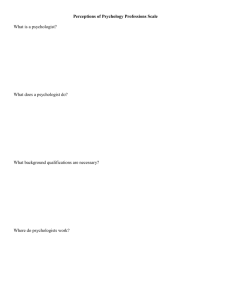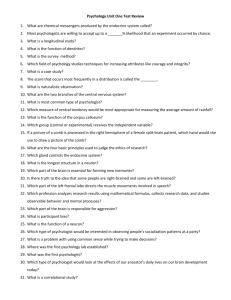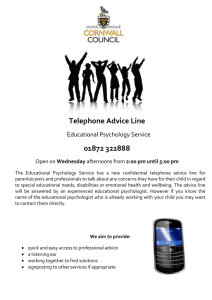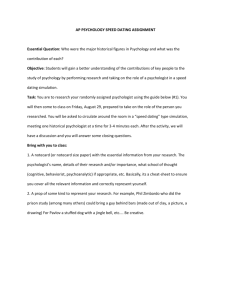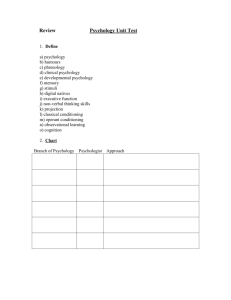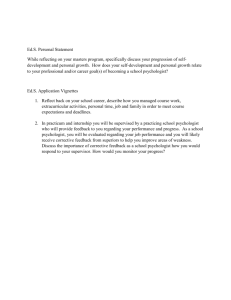Unit 1 Practice Test – Answer Key
advertisement
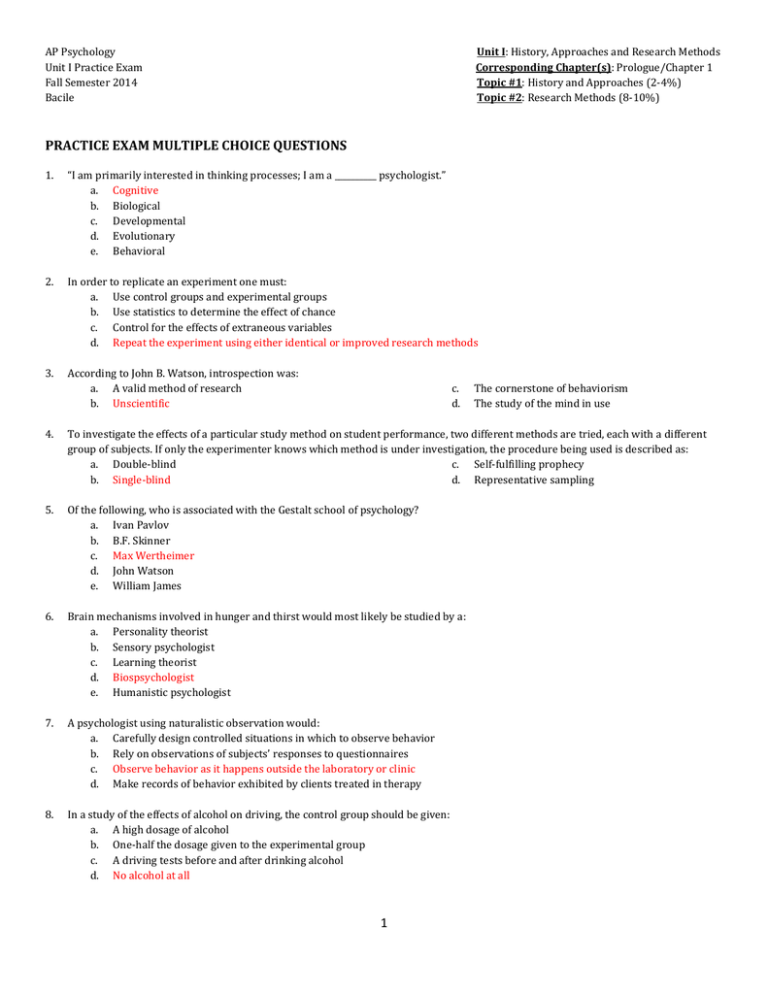
AP Psychology Unit I Practice Exam Fall Semester 2014 Bacile Unit I: History, Approaches and Research Methods Corresponding Chapter(s): Prologue/Chapter 1 Topic #1: History and Approaches (2-4%) Topic #2: Research Methods (8-10%) PRACTICE EXAM MULTIPLE CHOICE QUESTIONS 1. “I am primarily interested in thinking processes; I am a __________ psychologist.” a. Cognitive b. Biological c. Developmental d. Evolutionary e. Behavioral 2. In order to replicate an experiment one must: a. Use control groups and experimental groups b. Use statistics to determine the effect of chance c. Control for the effects of extraneous variables d. Repeat the experiment using either identical or improved research methods 3. According to John B. Watson, introspection was: a. A valid method of research b. Unscientific c. d. The cornerstone of behaviorism The study of the mind in use 4. To investigate the effects of a particular study method on student performance, two different methods are tried, each with a different group of subjects. If only the experimenter knows which method is under investigation, the procedure being used is described as: a. Double-blind c. Self-fulfilling prophecy b. Single-blind d. Representative sampling 5. Of the following, who is associated with the Gestalt school of psychology? a. Ivan Pavlov b. B.F. Skinner c. Max Wertheimer d. John Watson e. William James 6. Brain mechanisms involved in hunger and thirst would most likely be studied by a: a. Personality theorist b. Sensory psychologist c. Learning theorist d. Biospsychologist e. Humanistic psychologist 7. A psychologist using naturalistic observation would: a. Carefully design controlled situations in which to observe behavior b. Rely on observations of subjects’ responses to questionnaires c. Observe behavior as it happens outside the laboratory or clinic d. Make records of behavior exhibited by clients treated in therapy 8. In a study of the effects of alcohol on driving, the control group should be given: a. A high dosage of alcohol b. One-half the dosage given to the experimental group c. A driving tests before and after drinking alcohol d. No alcohol at all 1 9. Abraham Maslow proposed a need to develop one’s potential and be the best that one can be. This concept is known as: a. Self-image c. Self-esteem b. Self-concept d. Self-actualization 10. Developmental psychologists study the effects of __________ on behavior. a. Marketing b. Learning disabilities c. d. Aging Hormones 12. A psychologist who is “eclectic” can best be described as: a. Rejecting determinism in favor of free will b. Cognitive rather than behavioral c. d. Drawing from many psychological approaches Preferring pseudo-psychological approaches 13. The goals of psychology are to: a. Develop effective methods of psychotherapy b. Describe, predict, understand and control behavior c. d. Explain the functioning of the human mind Compare, analyze and control human behavior 14. A study to determine the degree of relationship between two events is called: a. A naturalistic observation b. A correlational study c. d. A controlled experiment The survey method 15. Freud believed that all thoughts and actions are determined by: a. The first year of life b. Forces in the personality that often unconscious c. d. Needs for love and self-esteem The drive for self-actualization 11. Which of the following psychologists was a Structuralist? a. B.F. Skinner b. John Watson c. Wilhelm Wundt d. William James e. Ivan Pavlov 16. Which of the following could serve as an experimental hypothesis? a. Although 25% of U.S. drivers say that they use the seatbelts in their cars, only 14% really do b. A case history of multiple personality appeared to be caused by traumatic childhood experiences c. College women who are anxious tend to want to spend time together d. As the temperature increases, the number of hit batters in baseball increases 17. Mariah is a psychologist. In her work with clients, she diagnoses and treats psychological problems and disorders. Mariah works in the field of: a. Cognitive psychology b. Developmental psychology c. Biological psychology d. Clinical psychology e. Quantitative psychology 18. To be confident that a cause-and-effect relationship exists, it is necessary to: a. Engage in naturalistic observation b. Develop a positive correlation 19. Which of the following psychologists used the humanistic approach? a. Sigmund Freud b. Abraham Maslow c. B.F. Skinner d. John Watson e. Edward Titchener 2 c. d. Perform a controlled experiment Test for a negative correlation 20. Which of the following represents an empirical statement? a. Government experts agree that a future downturn in the economy is likely b. The temperature today is higher than it was a year ago c. IQ is defined as mental age, divided by age in years, times 100 d. Grandmothers know best 21. The first psychology laboratory was established by: a. Edward Titchener b. William James c. John B. Watson d. Wilhelm Wundt e. Sigmund Freud 22. A researcher determines that the crime rate in a large city fluctuates with the phases of the moon. He concludes that the gravitational pull of the moon directly influences human behavior. He committed which of the following errors? a. He incorrectly inferred correlation from causation b. He incorrectly inferred causation from correlation c. He failed to measure the gravitational pull to test his hypothesis d. He has overlooked the placebo effect 23. John B. Watson would be most likely to agree with the beliefs of which of the following psychologists? a. Abraham Maslow b. Max Wertheimer c. William James d. B.F. Skinner e. Wilhelm Wundt 24. Which perspective would most likely explain anger as “an outlet for unconscious hostility”? a. Socio-Cultural b. Psychodynamic c. Behavioral d. Functionalist e. Biological 25. One of the limitations of the case study is that: a. There are few subjects for which it is applicable b. There are no control groups c. It is not applicable to the study of bizarre behavior d. It requires a large and expensive sample size 26. In an experiment to find out if taking Ginseng increases IQ scores, the IQ scores would be: a. The independent variable c. An extraneous variable b. A control variable d. The dependent variable 27. You see a psychologist and tell her that you are feeling depressed. The psychologist talks to you about your past and attempts to link your present situation with patterns developed in your childhood and your relationship with your parents. This psychologist would most likely belong to which of the following schools of psychological thought? a. Humanistic c. Behaviorism b. Psychodynamic d. Gestalt 28. A friend states that since he has been taking vitamin C, he has not had a single cold. His observation has little value in assessing the effects of vitamin C because: a. There was no control group for comparison b. He has not calculated a correlation coefficient c. Of the effect of the observer on the observed d. He does not specify his dosage of vitamin C 3 29. Subjects are said to be assigned randomly when: a. They are assigned to experimental and control groups from a sample which is representative of the larger population b. They each have an equal chance of being assigned to either the experimental or control group c. They are assigned to experimental and control groups so that the groups differ on some critical variable before the experiment begins d. Neither the experimenter nor the subject knows whether the subject is in the experimental or control group 30. You see a psychologists and tell her that you are feeling depressed. The psychologist focuses on those activities that make you feel depressed, and she talks with you about changing these activities and doing things that make you happy. This psychologist would most likely belong to which of the following schools of psychological thought? a. Humanistic c. Behaviorism b. Psychodynamic d. Gestalt 31. Which of the following coefficients of correlation indicates the strongest relationship between two sets of variables? a. -0.98 c. 0.00 b. 0.90 d. 1.20 32. An experimenter conducts an experiment on the effects of a drug to control hallucinations. He declares the results to be “statistically significant,” which usually means that: a. Even though appropriate statistics were used, no differences could be detected between experimental and control groups b. The results have important implications for theory or practice c. Differences between experimental and control groups of this size occur by chance only 5 times out of 100 (or less) d. Differences between experimental and control groups were so large they could never occur by chance alone 33. You see a psychologist and tell her that you are feeling depressed. She talks to you about the goals you have for yourself, about your image of yourself, and about the choices that you make in your life. This psychologist would most likely belong to which of the following schools of psychological thought? a. Humanistic c. Behaviorism b. Psychodynamic d. Gestalt 34. We wish to test the hypothesis that music improves learning. We compare the test scores of students who study to music with those who study in silence. Which of the following is an extraneous variable in this experiment? a. The presence or absence of music c. The amount of time allowed for studying b. The students’ test scores d. Silence 35. A correlation coefficient of -1.09 indicates a(n): a. Strong positive correlation b. Strong negative correlation c. d. Cause-and-effect relationship Error in computation 36. To prevent ethical abuse in psychological research, the APA has suggested that: a. Psychologists must treat all subjects with respect and concern for the subject’s dignity b. Psychologists must avoid deception when using human subjects c. All data collected from a person must be made public d. All psychological harm to subjects must be corrected by counseling 37. The effects of brain injury on personality would usually be investigated by the use of the: a. Experimental method c. Naturalistic observation method b. Case study method d. Survey method 38. In a weight-reduction experiment, an overweight individual was given what the researcher called a new type of diet pill that would help curb the desire to eat. In fact, the pill only contained powdered milk; however, ever since the individual started taking the pill, he has reported that his desire to eat has decreased. This illustrates the: a. Curvilinear relationship c. Natural experiment b. Effect of extraneous variables d. Placebo effect 4 39. The science of behavior and mental processes best defines a. Philosophy b. Cognitive neuroscience c. Basic research d. Applied research e. Psychology 40. The debate on the relative contributions of biology and experience to human development is most often referred to as: a. Evolutionary analysis d. The nature-nurture issue b. Behaviorism e. Natural selection c. The cognitive revolution 5
